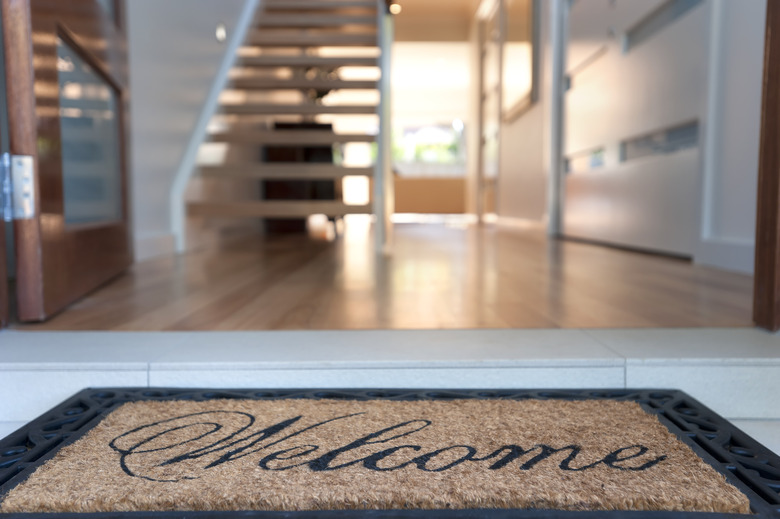What Makes A Home Uninhabitable?
We may receive a commission on purchases made from links.
There's no specific legal standard around what makes a home uninhabitable. The question usually comes up when an unhappy tenant has a dispute with their landlord. In many U.S. jurisdictions, courts hold landlords responsible for maintaining a habitable home, and tenants may be allowed to withhold rent money when the property isn't safe to live in. Legal standards aside, whether or not a home is safe to inhabit depends on a number of factors.
Tip
A home may be uninhabitable if it's constructed with dangerous materials, is structurally unsound, has a serious mold problem, lacks functioning electrical/plumbing systems or doesn't provide protection from extreme heat or cold — among other hazards.
Unsafe Building Materials
Unsafe Building Materials
Especially in older properties, dangerous materials may be lurking in the walls, floors and fixtures. Some homes are made with old insulation, vinyl floor tiles, roofing shingles and other building materials containing asbestos. These materials don't pose an immediate danger if they're intact but release asbestos fibers when they're disturbed. If that happens — say a DIY renovator starts ripping up old attic insulation without realizing the danger — it's not safe for people to continue living in the home until the problem is addressed. (Test your home for asbestos if you think it's present in your building materials.)
Other dangerous chemicals sometimes used in older building materials include chromated copper arsenate and formaldehyde. Chipping lead paint also poses an urgent safety risk, especially to kids and pets. Residents can use an instant lead test to detect lead in their homes.
Significant Structural Damage
Significant Structural Damage
It goes without saying that structural damage is a serious safety issue of the highest order. Minor cracks in a home's foundation or chimney don't necessarily mean everyone needs to evacuate, though you should have the building inspected quickly. Significant structural damage could cause part of the home to collapse at any time.
Major Mold Issues
Major Mold Issues
Some mold growth is common in homes. Mold can flourish in any moist environment, so you may spot some patches of mold on a damp basement wall or along a rotting wooden window frame. With minor outbreaks, you can treat and remove mold in your home on your own using products like mold treatment spray, but severe mold growth is another issue.
Mold can cause breathing problems and irritation for many people, especially those who have asthma or mold allergies. Sometimes, a severe mold outbreak can hide in the walls and grow over the course of months while residents experience worsening respiratory issues. You may need to move out of a home that has major mold problems until professional mold remediators can come in.
Excessive Cold or Heat
Excessive Cold or Heat
Providing protection from extreme temperatures is a basic function of a safe home. A home may be uninhabitable if gaps in the walls allow cold air and snow to blow in during the winter or if it gets dangerously hot during the summer. A safe home must also have functioning heat.
Lack of Functioning Plumbing and Electrical
Lack of Functioning Plumbing and Electrical
Our ancestors got through the day without electricity and plumbing, but that doesn't mean we should have to. Having access to running water is a basic requirement for a habitable home. So is a functioning and safe electrical system that's devoid of any faulty wiring or other damage that could be a fire hazard.
Other Factors Making Homes Uninhabitable
Other Factors Making Homes Uninhabitable
Security is a basic tenet of habitability. If a home is missing a door or window or doesn't have locks on exterior doors, a tenant could make a case that it's not safe to live there. Certain animal or insect infestations pose a threat to human health. (A home that's infested with ants may be technically habitable, but one that's overrun with rodents, bees or scorpions isn't.)
A home may also be uninhabitable if it lacks functioning smoke alarms or residents are exposed to carbon monoxide or radon. Radon is a dangerous radioactive gas, so homeowners have to mitigate radon before living in the home.
Sometimes, a home that's safe for one person is uninhabitable for another. For example, a wheelchair user or someone who has life-threatening asthma may have a different standard for what makes their home safe than someone else might.
References
- Cornell Law School: Legal Information Institute: Landlord-Tenant Law
- United States Environmental Protection Agency: A Brief Guide to Mold, Moisture and Your Home
- National Center for Healthy Housing: Potential Chemicals Found in Building Materials
- Apartments.com: What Makes a Rental Property Habitable?
